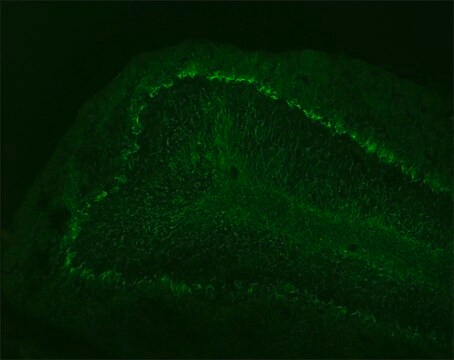MABN2431
Anti-phospho-NFL (Ser473) Antibody, clone 4F8
clone 4F8, from mouse
Synonym(e):
Neurofilament light polypeptide, 68 kDa neurofilament protein, Neurofilament triplet L protein
About This Item
Empfohlene Produkte
Biologische Quelle
mouse
Qualitätsniveau
Antikörperform
purified antibody
Antikörper-Produkttyp
primary antibodies
Klon
4F8, monoclonal
Speziesreaktivität
human, mouse
Speziesreaktivität (Voraussage durch Homologie)
rat (based on 100% sequence homology), bovine (based on 100% sequence homology), porcine (based on 100% sequence homology), rhesus macaque (based on 100% sequence homology)
Verpackung
antibody small pack of 25 μL
Methode(n)
immunohistochemistry: suitable
western blot: suitable
Isotyp
IgG1κ
NCBI-Hinterlegungsnummer
UniProt-Hinterlegungsnummer
Posttranslationale Modifikation Target
phosphorylation (pSer473)
Angaben zum Gen
human ... NEFL(4747)
Verwandte Kategorien
Allgemeine Beschreibung
Spezifität
Immunogen
Anwendung
Neurowissenschaft
Western Blotting Analysis: A representative lot detected phospho-NFL (Ser473) in Western Blotting applications (Rutherford, N.J., et. al. (2016). Acta Neuropathol Commun. 4(1):80).
Qualität
Western Blotting Analysis: A 1:500 dilution of this antibody detected phospho-NFL (Ser473) in mouse brain tissue lysate.
Zielbeschreibung
Physikalische Form
Lagerung und Haltbarkeit
Sonstige Hinweise
Haftungsausschluss
Sie haben nicht das passende Produkt gefunden?
Probieren Sie unser Produkt-Auswahlhilfe. aus.
Analysenzertifikate (COA)
Suchen Sie nach Analysenzertifikate (COA), indem Sie die Lot-/Chargennummer des Produkts eingeben. Lot- und Chargennummern sind auf dem Produktetikett hinter den Wörtern ‘Lot’ oder ‘Batch’ (Lot oder Charge) zu finden.
Besitzen Sie dieses Produkt bereits?
In der Dokumentenbibliothek finden Sie die Dokumentation zu den Produkten, die Sie kürzlich erworben haben.
Unser Team von Wissenschaftlern verfügt über Erfahrung in allen Forschungsbereichen einschließlich Life Science, Materialwissenschaften, chemischer Synthese, Chromatographie, Analytik und vielen mehr..
Setzen Sie sich mit dem technischen Dienst in Verbindung.



